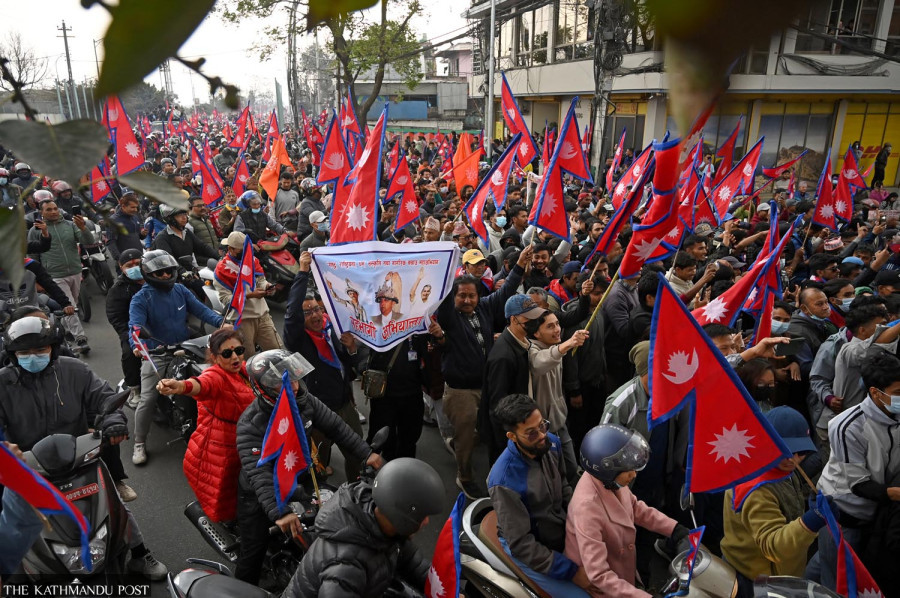Columns
Monarchist movement and disinformation
Highlighting socio-political and economic issues to advocate for regime change is unreasonable.
Jagadish Prasad Bist
Since the ouster of former King Gyanendra Shah after the 2006 People’s Movement, pro-monarchists have been engaging in periodic political rallies. However, protests supporting the Shah dynasty have become rampant recently, with the latest occurring on March 28. Two innocent lives were lost, and millions worth of property were damaged on the day.
Royalists became violent particularly after Shah made a public appeal on this year’s Democracy Day—the very system he destroyed with a coup d'état on February 1, 2005—to support his movement to restore monarchy. Pro-royalists have since threatened the current political system on the streets, in Parliament, in the media and beyond. And with it comes a flood of disinformation and false economic promises subtly presented in their arguments supporting the King.
Leaders of pro-monarchy political parties, who are well aware of the facts, are spreading disinformation on social and news media for their political gain. A common slogan heard at pro-royalist movements is ‘Raja Aau Desh Bachau’ (loosely translated as ‘King, come forward and save the country’). They believe the restoration of the king would save the country. But they seem to divert the attention of the naïve, politically frustrated and disillusioned public, who have lost faith in the current incompetent political leaders, not the democracy.
Disinformation on economy
The narrative of pro-royalists seems to present monarchy as omnipotent and the only panacea to the country’s socio-economic and political problems. Royalists often argue that the country has been economically and socially devastated over the past two decades since monarchy was demolished. However, the issues cannot be simply attributed to overthrowing monarchy and establishing a democracy. Using the same idea to call for a resurrection of monarchy is disinformation per se. Such problems are prevalent because of the shortsightedness of the leaders at the policy level for decades.
Corruption was worse during the direct rule of King Gyanendra from 2005 to 2008. According to the Corruption Perception Index (CPI) by Transparency International, Nepal’s score has improved significantly over the last two decades, increasing from 25 in 2005 to 34 in 2024. Reliance on debt for the budget was as equivalent as today, 40 percent in 1990. Foreign direct investment was 0.002 percent in 1972, 0.01 percent in 1990, negative 0.01 percent in 2000 and 0.18 percent in 2023. Likewise, the exodus of skilled and unskilled labour force from the country is not because of democracy. The trend started in 1990, following an open market economy. Although it has become more rampant in recent years, there is no guarantee that reestablishing the monarchy will end it.
Similarly, royalists often argue that the current presidential system has become too expensive for the country to sustain itself. Hence, the monarchy is economically viable for a small economy like Nepal. However, history tells a different story. According to the budget archives in the Ministry of Finance, historically, the monarchy remained very expensive. Budget archives from 1969 show that about 5 percent of the national budget was allocated towards the royals, while the current budget allocated for the Office of the President is about 0.01 percent.
During Shah’s reign, the budget in absolute terms reached about Rs330 million in 2005, which, even ignoring the discounted time value of money over two decades, is more than 60 percent of the total budget allocated for the Office of the President in the fiscal year 2025. If we include the time value of money, even at a modest 5 percent interest rate, ex-King Shah’s expenses on taxpayers’ accounts would amount to about Rs900 million in today’s value—more than four times the budget, Rs203 million, allocated for the Office of the President in 2025.
On a positive note, data shows that Nepal has made impressive improvements over the past two decades in reducing poverty from 30.9 percent in 2004 to 20 percent in 2022, increasing the literacy rates from 49 percent in 2001 to 77 percent in 2021, improving gender inequality from gender inequality index of 0.67 in 2001 to 0.48 in 2013 and overall human development indicators have progressed from low index of 0.5 in 2008 to medium value of 0.59 in 2022.
The real problem
The irony is that, on the one hand, the leaders of monarchy movement advocate for a constitutional monarchy—a system where the king or queen has no influence whatsoever over the country’s economic, social, political, or any other policies—while on the other, they portray the king as a saviour. But how can a powerless constitutional monarchy without any real influence on the country’s policies be the solution to Nepal’s economic, social and political crises?
There is no denying that the royalists’ depiction of the economy—prevalent of corruption, misgovernance and public frustration, as in the monarch’s time—is valid and requires much political and economic attention. However, these problems do not require monarchy, let alone a regime change. The problem today is not democracy but the leaders in power, who can be replaced through elections.
Therefore, weaponising the current issues and strategically laying out false promises that are not overtly stated but indirectly and strategically presented in support of King is outright disinformation. Let’s not forget that, except for blaming democracy, neither the former King nor the leaders of political parties supporting monarchy have proposed any economic or political strategies to solve the country’s problems. Their movement is only stirring the public towards a direction that could erode their hard-won democracy and freedom.




 13.84°C Kathmandu
13.84°C Kathmandu.jpg)













.jpg&w=300&height=200)
